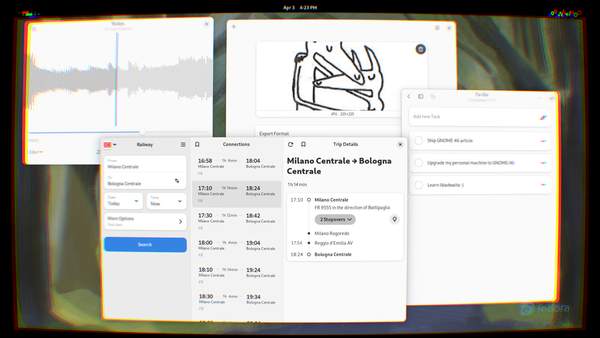Snapdragon X Elite - Major ARM performance boost, but should you go out and buy it?
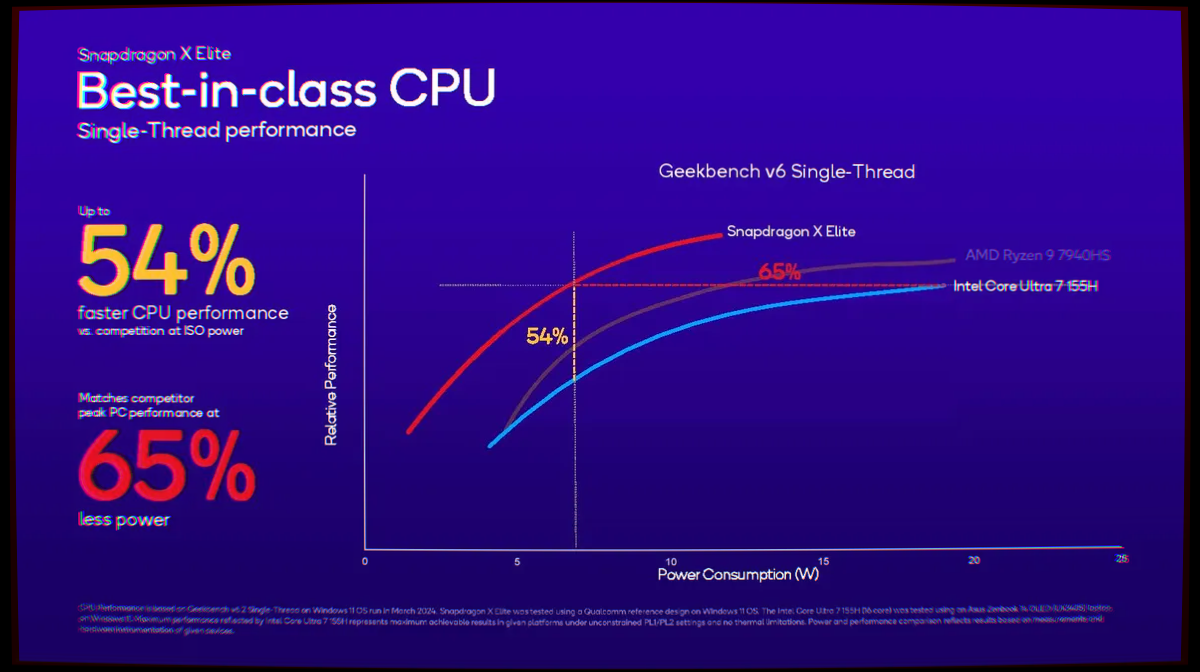
If you have been following the news as of late, you will have noticed there is an ongoing craze for ARM-based laptops: more of them are hitting the market, and several people seem to want one. But first, let's take a step back: what are they and why should you care?
What is ARM?
ARM indicates one of the most popular family of RISC processors, and it is much different from the processors we currently use on laptops - which are of the "x86" type.
There are some key differences between these two families of processors. The most obvious one is the Instruction Set Architecture. The Instruction Set Architecture, ISA in short, is a fundamental part of the CPU, and it is a model that defines what instructions, data types and registers the CPU supports. There are two main approaches: "CISC", which stands for "Complex Instruction Set Computer", and "RISC", which stands for "Reduced Instruction Set Computer".
Standard x86 processors made by Intel and AMD are of the latter type - CISC - while ARM processors are RISC. These two approaches have several pros and cons - but, to cut it short, the industry has realized that RISC is the way to go for a lot of workloads.
big.LITTLE Architecture
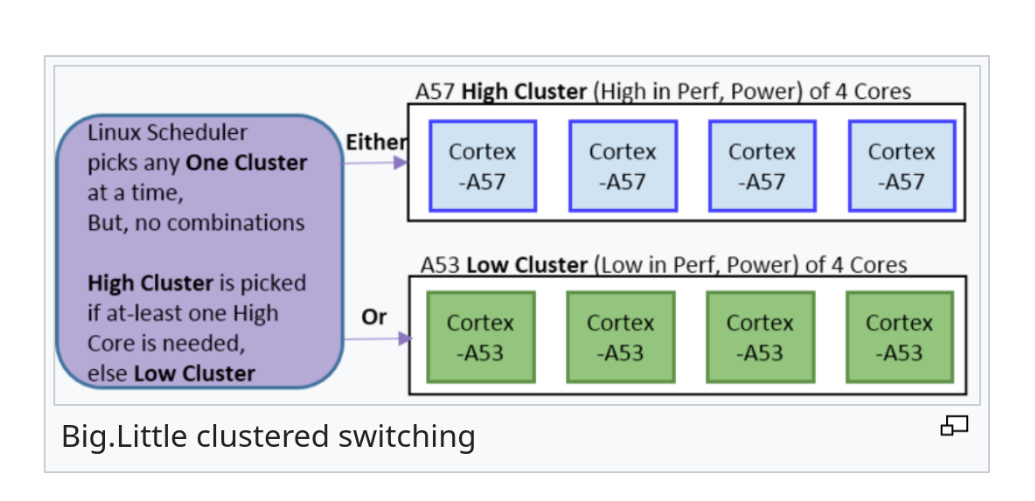
The main selling point of ARM processors is that they are able to work by consuming very little power, which makes them suitable for use in phones, tablets and other embedded devic
es. Many strategies are used to prioritize efficiency in ARM design - including the use of a mixed core architecture called "big.LITTLE". In fact, you will often come across some ARM chips that have a few "big" cores that are very powerful and fit for performing heavy tasks - albeit at the cost of consuming more power and producing more heat, accompanied by a series of "small" cores, which are better suited for lightweight or background tasks, since they aren't as fast, but they draw much less power and produce much less heat. This system works quite well: the foreground tasks, where performance is required, will be handled by the big cores, while more lightweight tasks, such as background services to check for notifications or e-mail, will typically be scheduled on the little cores. If this is done intelligently, the slower cores will be assigned tasks that are not time-sensitive, so the user will have the impression of using a system that is fast and responsive while being very efficient with battery consumption.
Apple Silicon
But why are these chips so desirable? Basically, because of Apple. Back in 2020, in fact, Apple announced a new line of MacBook laptops. They had a fundamental difference compared to the previous lineup: instead of using Intel CPUs and AMD dedicated graphics cards, they switched to using "Apple Silicon", Apple's own take at an ARM processor. The benefits were pretty clear: Apple SIlicon laptops delivered excellent performance while maintaining very long battery runtime also allowing the most portable and lightweight laptops of the bunch to run completely fanless, like phones and tablets already do. They were really that efficient.
That is not casual: before making it to laptops, ARM chips have been widely adopted by smartphones and tablets for a lot of time. They have been an excellent way to have a good level of performance with moderate battery consumption.
The results in Apple's implementation have been just excellent, but not everybody wants a MacBook. While they are good machines, there are valid reasons not to get them. Due to this, more and more people have been wishing they could have the same efficient and fast package on another non-Apple laptop - perhaps something more repairable, like Framework, or that runs Linux better.
For that reason, it was only a matter of time until other chip manufacturers would have tried following Apple's footsteps. Sadly, for years, those attempts have been fruitless, and ARM designs launched on the market to compete with Apple's MacBooks have been underwhelming on multiple fronts, failing to provide the level of performance people were looking for. Now, however, we might have some hope, as Qualcomm has finally launched a new ARM SoC, called the Snapdragon X Elite, which is finally supposed to be good competition for Apple, Intel and AMD. Amazing! But does that mean you should stop doing whatever you're doing right now and go pre-order a laptop with one of these? Short answer - hold your horses, not so fast. Let's go dig down a little, shall we?
The Snapdragon X Elite
The Snapragon X Elite and X Plus are Qualcomm's new laptop-grade ARM chips that have just been released. You might already be familiar with this branding, as Snapdragon is one of the most popular family of chips for Android phones. If you are using an Android device to watch this video, the chance you are using a Snapdragon processor is high!
Unlike previous attempts at bringing Snapdragons to full-blown laptop computers, though, this attempt seems to be different. First of all, these SoC's are using Qualcomm's brand-new "Oryon" cores, which Qualcomm claims are able to push out better performance while staying more efficient. If Qualcomm has played their cards rights, these new cores might start to rival Apple's own cores, which are so far a very good compromise between performance and power consumption.
The more powerful of the two is the Snapdragon X Elite, which boasts a whopping 12 cores that run at a constant clock speed of 3.8 GHz, and can boost up to a respectable 4.3 GHz on the "big cores". The X Core is the more modest sibling, with "just" 10 cores running at 3.4 GHz each.
On both, the GPU is an Adreno unit that does support connecting to 4k 120 Hz displays and up to three external 4k monitors - which is already a big advantage over several of Apple's own chips, that are way less decked out, as far as video outputs go.
There is also a NPU (which stands for Neural Processing Unitneural processin) - a dedicated processor for AI-related computations - that can reportedly process up to 4.6 TFLOPS - theoretically making it the fastest NPU on a laptop thus far.
Native upstream Linux support
Why are we even talking about this chip, on a Linux channel, though? Looking at what mainstream press coverage the X Elite has gotten thus far, it definitely appears to be a chip intended for the Windows ARM experience in the first place, with Microsoft adopting it in their newest Surface devices mostly to leverage the very fast on-board NPU to use with Copilot, the AI suite they have recently implemented in Windows.
In fact, I would go as far as to say that the use case of this processor on Windows is actually not that interesting. There have already been numerous attempts at commercializing Windows on ARM in the past, but it just was never meant to be: Microsoft's operating system is still way too deeply rooted in its own x86 origins, with the "Windows on ARM" translation layer being average at best at doing its job, and a similar amount of Windows applications being available for ARM processors without lousy, slow x86 emulation.
The situation is much better on Linux on ARM. Mainly, this is because Linux running on ARM chips has been a thing for a really long time (in fact, it has been running on most phones for over a decade now!). On top of that, we have to remember that the Linux ecosystem is built on free software, and free software is a big part of what most users install on their computers - which means it's far easier, as a community, to port the most popular software to native ARM.
However, that means nothing until an ARM SoC (System-on-Chip) does not have proper and mainlined support for Linux - as in, the real Linux kernel, rather than a patched version distributed by the vendor that will only enjoy a limited support window before being deprecated. In general, running Linux is no fun when your hardware does not properly support it: fighting with your hardware constantly is something you really don't want to have to do, if you are planning to do any work with your computer. So far, we have some great news: Qualcomm has laid down their plans to provide full, upstream Linux support for the X Elite. It's not all just talk either - the company has already promptly submitted the relevant patch sets to the Linux kernel within just a few days of announcing these processors.
How the Linux support works
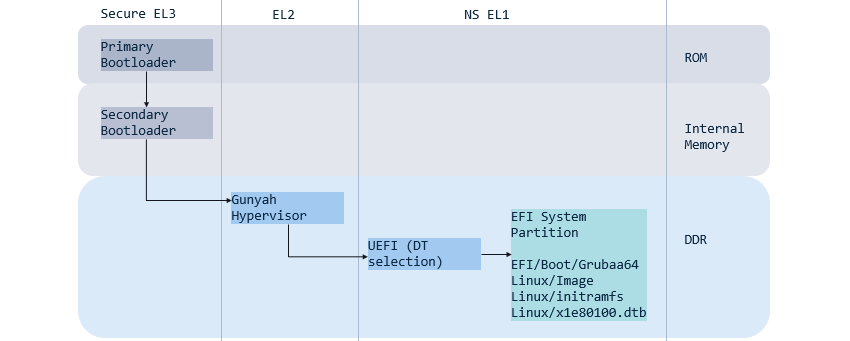
The Snapdragon X Elite supports full UEFI boot - the same standard that you currently use to boot Linux on your Intel or AMD laptop right now. To boot into Linux, the SoC leverages the ARM DeviceTree - which is, fundamentally, ARM's way of enumerating the devices that need to be initialized and let the OS know. From there, a bootloader, like GNU GRUB or the much newer systemd-boot, gets executed, and can be used to boot into Linux. Interestingly, Qualcomm claims that dual boots with Windows are supported - which was unexpected, but it's great to see, for those people who just can't let Windows go completely just yet for whatever reason.
One question remains: what exactly will work? Will Linux just boot, or will everything work properly? This is something that needs to be seen when those devices are actually released. There is one good sign though: due to the integration ARM SoC's have, it is very likely that the delta between two Snapdragon X Elite systems will be much less, than, say, the delta between two Ryzen 7 7840U systems. In fact, x86 laptops, being much more modular, also have room for much more variegated OEM configurations - and that is what requires people to buy laptops that enjoy proper and full Linux support, like Framework or Tuxedo, to ensure they are running on a tested configuration.
Upgradability
Another question that remains is whether there will exist Snapdragon X Elite laptops with non-soldered RAM and storage. In fact, this chip only supports LPDDR memory - not classical, modular SODIMM DDR5 memory. LPDDR5 is most often found soldered directly to the motherboard - but it's not impossible we will see implementations using LPCAMM2, a new format that allows for swappable, upgradable LPDDR5 RAM. Whether this will happen or not is yet to be seen. At least, unlike on Apple's implementation, the memory is not on die, which means that it should theoretically be possible to have modular memory with a 256-bit bus with two LPCAMM2 slots.
Synthetic proprietary benchmarks should be taken with a grain of salt
In several of Qualcomm's own private tests, these new processors appear to outperform some of their most fierce competition in the laptops space - the Intel Core Ultra 7 155H and the AMD Ryzen 9 7940HS, two processors that absolutely hold their own as far as performance goes, and allow for fairly heavy computations on the go - which would make this processor worth considering, especially since past laptop-tier Qualcomm SoC's have really never been particularly worth calling home about, pulling average at best performance in most cases.
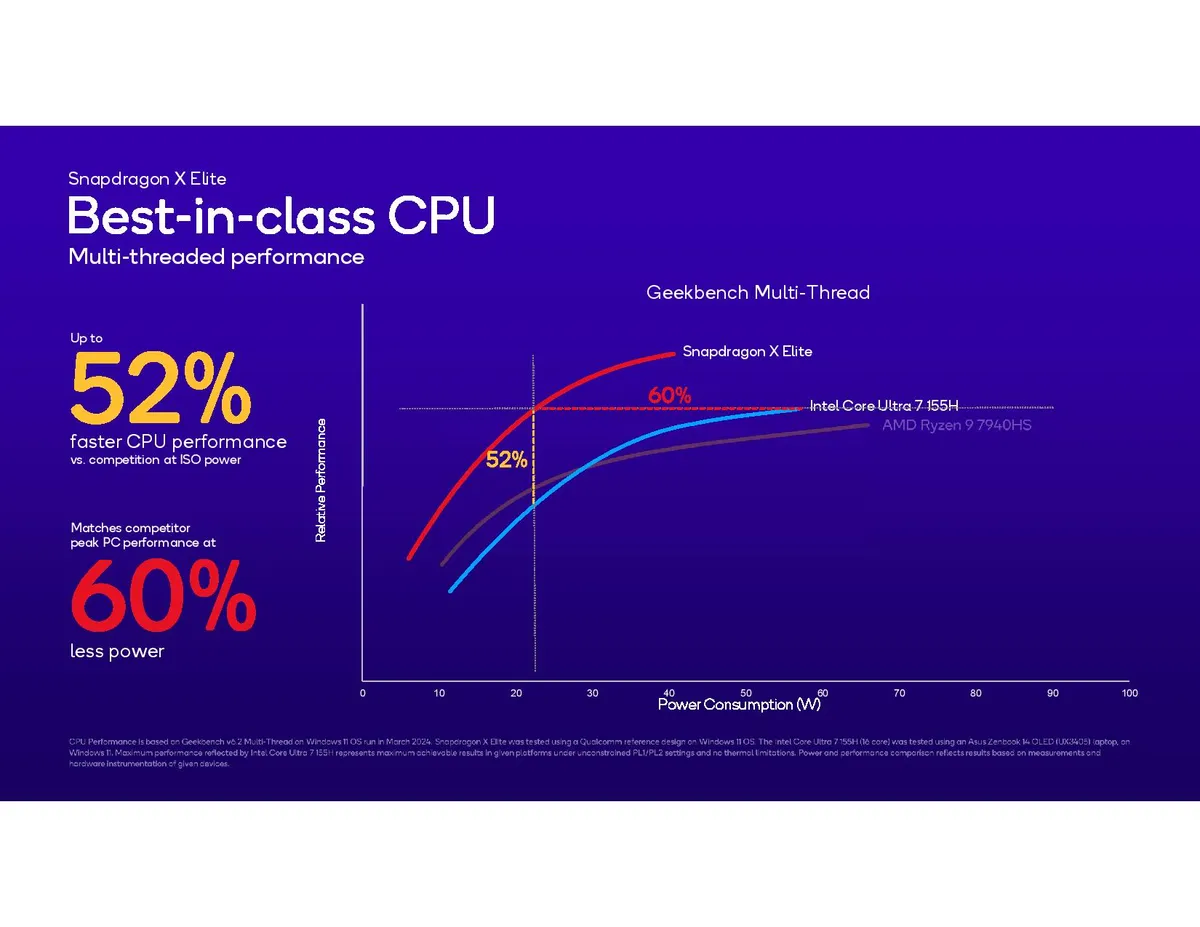
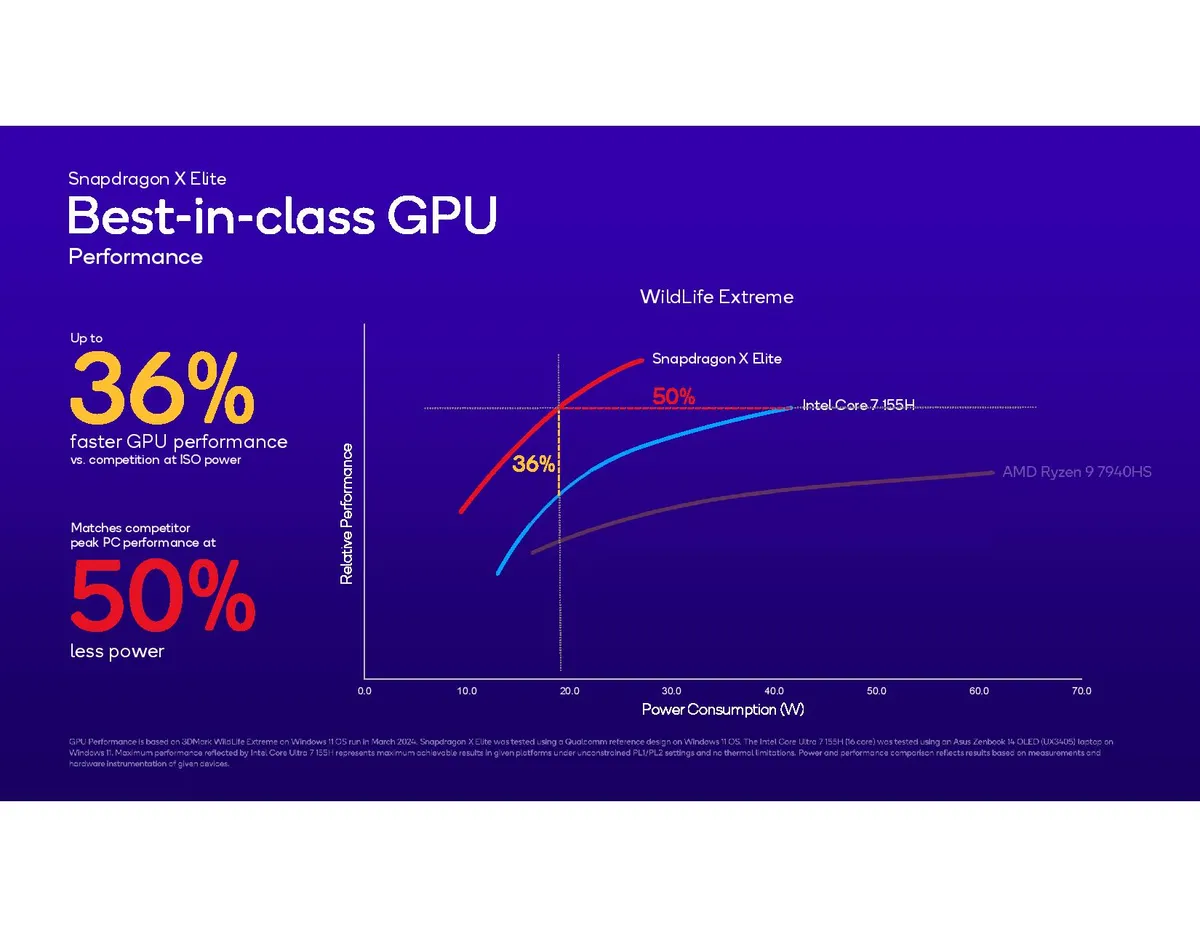
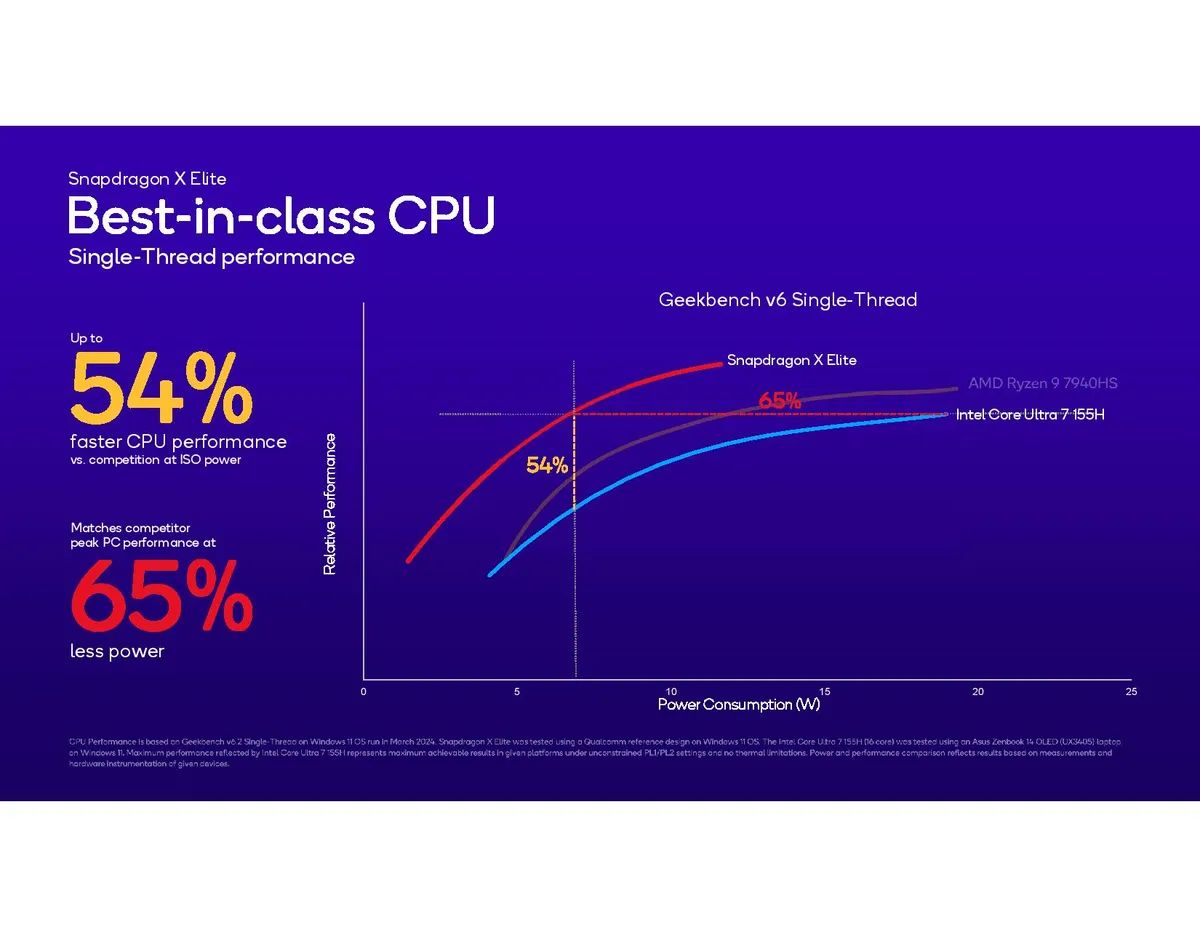
Microsoft has also announced similar numbers for their upcoming Surface devices with these processors. However, as with all first-party benchmarks, it's important to take them with a grain of salt, as real-world performance has not been yet tested by a reliable third party. We have seen that similar tests done by other companies have, in the past, relied on cherry-picked data to boost the numbers. Therefore, we should stay cautiously optimistic about the performance, but still knowing these numbers are not final.
I'll tell you more: we have only scratched the surface on how meaningless these first-party test results are. Let's go on.
AMD and suspicious testing methodologies
Something else to consider is the elephant in the room: AMD. Year after year, in fact, AMD's laptop chips have gotten better and better efficiency-wise, a phenomenon which has made the gap between AND U-series laptop chips and Apple Silicon chips on the same generation smaller and smaller. In fact, while Apple Silicon still leads in efficiency when performing lightweight tasks, there have been multiple instances where AMD's silicon has been carrying Apple's during more heavy-duty work.
The most apt of you will have already noticed that AMD's U-series processors are completely missing from Qualcomm's comparison tests on the graph. In fact, the two x86 chips the Elite was compared to were the Intel Core Ultra 155H and the AMD Ryzen 9 7940HS. The former is an Intel processor: it's Intel's first successful attempt at improving efficiency compared to previous generations, but it's not quite up there with AMD yet. On the other hand, the 7940HS is not a comparable chip. While the 155H has a TDP of 28W, in fact, the Ryzen 9 here is typically found at a TDP of 45W and 55W. HS-series Ryzen CPUs share a lot of the same silicon as the U series, but they are not tuned to be efficient, they are tuned to be fast. They run faster than their lower-power siblings, of course, because they are fed more power and are optimized at working in higher ranges of TDP. These are processors you will most often see in mobile workstation or gaming laptops, like the girthy Framework Laptop 16 - the kind of machine you get when you want pure performance on the go, with little consideration for things like all-day battery life or an ice-cool chassis. Considering it is also unclear what TDP the Ryzen 9 in question was set at, there is definitely something dubious in the methodology being used here, as there is a chance that the gap with existing AMD CPUs that you can already buy is actually not that great, and Qualcomm has used the most high-power iteration of that mobile single-package Ryzen silicon set at its highest TDP yet, in order to downplay the efficiency of AMD's excellent Phoenix Point platform enough to make the X Elite still look good.
Another curious choice is the use of last gen's 2023 Ryzen 9 7940HS instead of the more contemporary 8000-series refresh which, while being based on the same CPU and GPU silicon, has received further optimizations allowing it to be more efficient - especially at lower TDP ranges. But the most important difference we find in this year's refresh is the much improved NPU. Qualcomm is betting a lot on its NPU compute performance, as they have been working closely with Microsoft to launch a NPU that provides performance that meets Microsoft's specification of around 40 TOPS minimum to run Copilot AI tasks locally, so it is very interesting that they purposefully skipped the more current 2024 refresh where AMD has massively improved the NPU performance of their chips. What this means is that the gap in local AI performance between the X Elite and contemporary AMD Ryzen chips is certain to be much smaller than what these graphs show.
In short, to provide a fair and meaningful comparison, Qualcomm should have picked the Ryzen 7 8840U instead of the 7940HS. It is the latest generation, there are already several laptops sporting it available on the market, it runs at the same 28W TDP as the Intel chip they are comparing it to, it has the newest efficiency optimizations by AMD and, most importantly, it has the newer, much improved NPU. So far, this looks really bad and it begs the question: is Qualcomm cheating and desperately trying to hide the fact that their new highly-hyped ARM processors are actually not that far above current AMD offerings, that can be already bought and paid for today, at much lower prices, and with access to far more programs than ARM chips currently do? This is not something we can answer yet - but what we are seeing in the test methodology is certainly not a good sign.
Wrap up: promising processors, but don't buy into the hype immediately
To wrap up, the new Snapdragon platform is without a doubt very interesting, since it paves the way for ARM on laptops, bringing a glimmer of hope that we will have proper, efficient, Apple Silicon - like, fully supported Linux laptops available for purchase in the near future. At the same time, the fact that full Linux support is still an ongoing effort and the fact that the official test m
ethodologies are very flawed to say the least raises enough doubts that it's safe to say that Linux users should hold off for now and wait how things evolve.
In case you are looking for a laptop upgrade right now, though, you can already bring home a very capable and efficient Linux machine - one that might actually not be far behind these up and coming ARM laptops, while simultaneously avoiding all of the early adopter pains that ARM laptops come with, like limited support for many programs and having to run the kernel on largely untested hardware. There are several Linux laptops with the latest AMD U-series silicon you can buy today, like one of our favorites, the modular and repairable Framework Laptop 13 with a Ryzen 7 7840U, or Tuxedo's new Pulse Gen 4 laptop, with the refreshed Ryzen 7 8840U chip - the one Qualcomm should have tested their new SoC's against instead.

